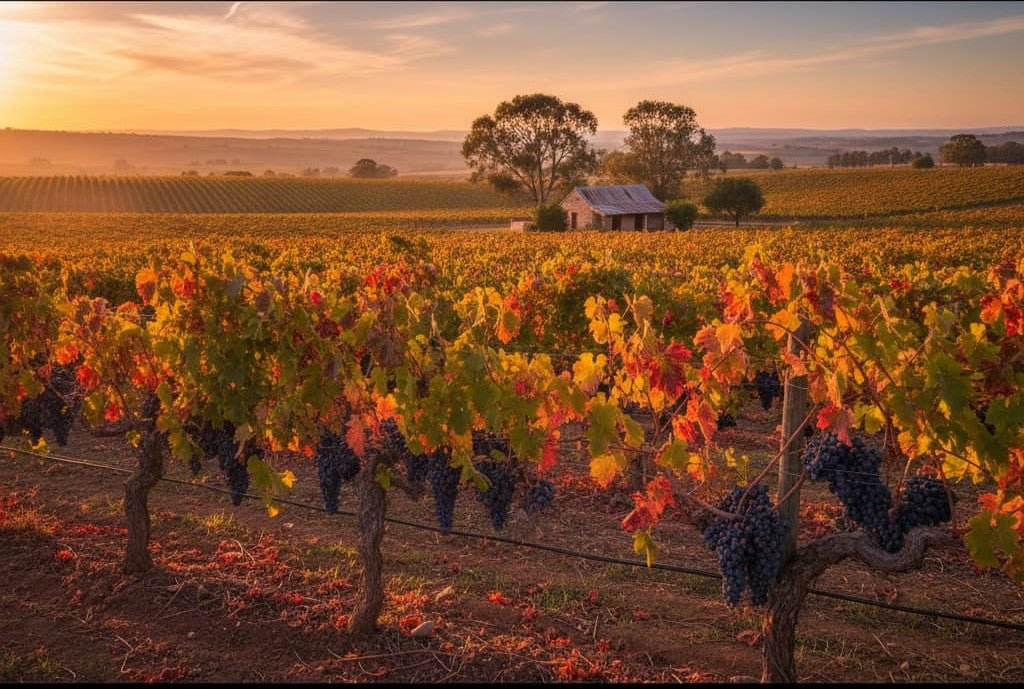
Wines of Australia & New Zealand: Barossa, Margaret River & Marlborough
Share
Southern Hemisphere Wonders: The Wines of Australia & New Zealand

🍇 The Spirit of the South
From golden coastlines to alpine peaks, Australia and New Zealand share a devotion to purity, craftsmanship, and respect for the earth. These wines are the product of bold pioneers, indigenous soil, open skies and a modern love for terroir-driven expression.
🗺️ Wine Regions at a Glance
| Region | Country | Climate | Key Grapes | Signature Style |
|---|---|---|---|---|
| Barossa Valley | Australia | Warm, Mediterranean | Shiraz | Bold, rich, generous |
| Margaret River | Australia | Maritime | Chardonnay, Cabernet Sauvignon | Elegant, oceanic, refined |
| Yarra Valley | Australia | Cool, misty | Pinot Noir, Chardonnay | Delicate, aromatic |
| Marlborough | New Zealand | Sunny days, cool nights | Sauvignon Blanc | Fresh, zesty, vibrant |
| Central Otago | New Zealand | Alpine, intense sun | Pinot Noir | Complex, mineral, refined |
Australia — Crafting Sunshine in a Glass
Barossa Valley — Bold Heritage
Founded in the 1840s by German and English settlers, Barossa Valley is one of Australia’s oldest wine heartlands. Early immigrants carried vine cuttings and a devotion to cellar craft that still shapes the region’s character today. The valley’s deep, iron-rich soils and abundant sunshine produce grapes of remarkable concentration — especially Shiraz from vines that in some vineyards date back more than a century.
Through wars, droughts, and economic shifts, Barossa families preserved their craft. Estates like Henschke and Seppeltsfield built reputations for age-worthy wines, and the annual Barossa Vintage Festival keeps the communal spirit alive — parades, shared feasts, and cellar doors that open like family homes.
Winemaking Signature: Hand-harvested Shiraz, open-top fermentation vats that allow gentle extraction, and aging in seasoned American oak barrels for cocoa, spice and rounded tannin.
Typical Tasting Notes: Dark berry compote, black chocolate, cracked pepper, a hint of smoked meat.
Perfect Pairing: Slow-roasted lamb, smoked brisket, or dark chocolate with sea salt.

Margaret River — Ocean Elegance
Though young by Old World standards, Margaret River's rise is a study in thoughtful planning and place-making. In 1967, Dr. Tom Cullity planted the first commercial vines at Vasse Felix after recognising a coastal microclimate strikingly similar to Bordeaux’s. The region’s identity evolved quickly: cool ocean breezes, maritime soils, and a landscape of karri forest and turquoise coves.
Margaret River became known for balance — Chardonnay that is crisp yet textural, and Cabernet Sauvignon with noble structure and coastal minerality. Winemakers prize gentle handling and small-lot fermentation so the fruit and the sea-borne minerality remain the stars.
Winemaking Signature: Gentle hand-picking, wild yeast fermentations for character, barrel aging in fine French oak for nuance.
Typical Tasting Notes: Pear, white peach, hazelnut, sea-spray minerality, subtle citrus zest.
Perfect Pairing: Seared scallops, truffle risotto, or creamy pasta with lemon butter.
Host’s tip: Book a cellar-door lunch and then a short drive to a secluded beach — Margaret River is as much about landscape as it is about wine.

Yarra Valley — The Art of Refinement
The Yarra Valley traces its origins to 1838, one of Australia’s earliest viticultural experiments. It flourished, declined, and was reborn in the late 20th century by a generation of innovators who saw its cool-climate potential. Visionaries such as Bailey Carrodus and John Middleton championed Pinot Noir and Chardonnay, prioritising terroir expression over heavy manipulation.
Today, the Yarra blends traditional cellar craft with modern sustainability. The region’s wines are known for clarity, floral perfume and restraint — ideal for those who appreciate nuance and time-honoured technique.
Winemaking Signature: Cold-soak for Pinot Noir to build aromatic depth, whole-bunch fermentation for structure, and lees-aged Chardonnay for creaminess without heaviness.
Typical Tasting Notes: Red cherry, wild strawberry, forest herbs, subtle spice.
Perfect Pairing: Roast duck, truffle risotto, or a platter of local cheeses.

New Zealand — Purity in Every Drop
Marlborough — The Global Pioneer
Once largely pastoral land, Marlborough’s transformation into a world-class wine region is one of the late 20th century’s great success stories. The planting of Sauvignon Blanc in the 1970s, and the global embrace that followed — epitomised by Cloudy Bay in 1985 — made Marlborough synonymous with clarity, brisk acidity and a new kind of white-wine energy.
Its long sunlight hours, cool nights, and free-draining riverbeds give grapes bright aromatics and intense fruit concentration. While Sauvignon Blanc remains the region’s calling card, winemakers are pushing variety and technique — exploring single-vineyard expressions, barrel-fermented whites, and textured Pinots.
Winemaking Signature: Night harvesting to preserve aromatics, cool stainless-steel fermentation for fruit purity, with selective barrel aging for complexity.
Typical Tasting Notes: Lime, passionfruit, gooseberry, crushed herbs, sea-spray lift.
Perfect Pairing: Fresh oysters, green-lipped mussels, or a citrus-goat-cheese salad.

Central Otago — The Southernmost Secret
Central Otago’s story begins with gold — settlers arrived in the 1860s and noticed the region’s fruit-growing potential. Serious viticulture waited until the late 1970s, when pioneers planted vines in stoney soils and embraced the high-altitude climate. Their boldness yielded a region capable of producing Pinot Noir with striking concentration and mountain-bred vitality.
The climate is dramatic: very warm afternoons and cold nights, intense sunlight and poor soils that force vines to concentrate flavours. The result: wines with precision, intense aromatic lift, and fine-grained tannin that often surprise those who expect only rustic fruit.
Winemaking Signature: Hand-harvested, small-batch fermentation, gravity-flow cellars, and subtle French oak aging to retain vibrancy while adding texture.
Typical Tasting Notes: Wild strawberry, red cherry, violet perfume, and mineral undercurrents.
Perfect Pairing: Venison with cherry glaze, truffle mushrooms, or rosemary lamb shank.

🎉 Celebrations of Wine & Culture
Wine here is celebrated with festivals that embody local rhythm — harvest parades, seaside feasts, and intimate grape-focused gatherings. Below are the marquee events that bring each region’s story to life.
Barossa Vintage Festival
Where: Barossa Valley, South Australia — When: Biennial (March–April)
A parade of floats, community dinners and open cellar doors celebrate Barossa’s generational winemaking. Families wear vintage dresses, scarecrow trails wind through vineyards, and long lunches show the valley’s communal heart.
Margaret River Gourmet Escape
Where: Margaret River — When: November
Top chefs and winemakers turn the coastline into a culinary playground. Open-fire dinners, masterclasses, and seaside tastings make this a must for travellers who love food and wine in equal measure.
Lost in the F.O.G. — Festival of Grenache
Where: Barossa (select estates) — When: Late June
An intimate, varietal-focused festival that highlights Grenache and its storytelling potential. Expect bonfires, walk-around tastings, and producers sharing micro-lot releases.
Marlborough Wine & Food Festival
Where: Renwick Domain — When: February
New Zealand’s longest-running wine and food event, full of masterclasses, local produce and the region’s famed Sauvignon Blancs. It’s as much about community and craft as it is about tasting.
Central Otago Pinot Celebration
Where: Queenstown & Central Otago — When: January
An elegant three-day celebration of Pinot Noir — tastings, dinners and curated vineyard visits in a dramatic alpine setting.
Travel tip: If attending festivals, book accommodation 3–6 months in advance; many events coincide with harvest and peak visitor seasons.

🪶 The Craft — How These Wines Are Made
Across these regions, winemaking shares a few key philosophies: respect the vineyard, minimise unnecessary extraction, and let place guide the bottle. Below are common techniques and why they matter.
- Hand-harvesting: Gentle picking preserves pristine fruit and reduces the extraction of harsh tannins.
- Cold fermentation: Used for aromatic whites (Marlborough) to lock in bright fruit and acidity.
- Open-top & whole-bunch fermentation: Adds texture and complexity to reds (Barossa, Otago, Yarra).
- Barrel aging (French/American oak): Adds structure, spice and silk — used judiciously to enhance, not mask.
- Minimal filtration & natural yeasts: Increasingly common for wines that want to speak more clearly of their site.
🍽️ Perfect Pairings — Quick Reference
| Wine | Region | Best Pairing |
|---|---|---|
| Shiraz | Barossa Valley | Slow-roasted lamb, smoked brisket |
| Chardonnay | Margaret River | Seared scallops, truffle risotto |
| Pinot Noir | Yarra Valley / Central Otago | Roast duck, mushroom risotto |
| Sauvignon Blanc | Marlborough | Oysters, citrus salads |
